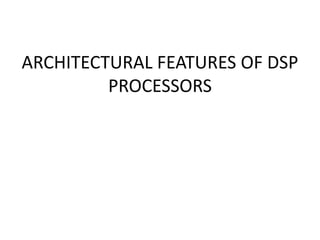
Dsp lab seminar
- 1. ARCHITECTURAL FEATURES OF DSP PROCESSORS
- 2. Basic Architectural Features of DSPs • Data path configured for DSP – Fixed-point arithmetic – MAC- Multiply-accumulate • Multiple memory banks and buses - – Harvard Architecture – Multiple data memories • Specialized addressing modes – Bit-reversed addressing – Circular buffers • Specialized instruction set and execution control – Zero-overhead loops – Support for fast MAC – Fast Interrupt Handling • Specialized peripherals for DSP
- 3. DSP Data Path: Arithmetic • DSPs dealing with numbers representing real world => Want “reals”/ fractions • DSPs dealing with numbers for addresses => Want integers • Support “fixed point” as well as integers
- 4. DSP Data Path: Multiplier • Specialized hardware performs all key arithmetic operations in 1 cycle • 50% of instructions can involve multiplier => single cycle latency multiplier • Need to perform multiply-accumulate (MAC) • n-bit multiplier => 2n-bit product
- 5. DSP Data Path: Accumulator • Don’t want overflow or have to scale accumulator • Option 1: accumulator wider than product: “guard bits” – Motorola DSP:24b x 24b => 48b product, 56b Accumulator • Option 2: shift right and round product before adder
- 7. DSP Memory • FIR Tap implies multiple memory accesses • DSPs require multiple data ports • Some DSPs have ad hoc techniques to reduce memory bandwidth demand: – Instruction repeat buffer: do 1 instruction 256 times – Often disables interrupts, thereby increasing interrupt response time • Some recent DSPs have instruction caches – Even then may allow programmer to “lock in” instructions into cache – Option to turn cache into fast program memory • No DSPs have data caches. • May have multiple data memories
- 8. Memory Architecture Comparison DSP Processor: • Harvard architecture • 2-4 memory accesses/cycle • No caches-on-chip SRAM General-Purpose Processor: • Von Neumann architecture • Typically 1 access/cycle • Use caches
- 9. DSPAddressing • Have standard addressing modes: immediate, direct, register ,indirect. • Want to keep MAC data path busy • Assumption: any extra instructions imply clock cycles of overhead in inner loop => complex addressing is good • Autoincrement/Autodecrement register indirect
- 10. DSPAddressing: FFT • FFTs start or end with data in butterfly order 0 (000) => 0 (000) 1 (001) => 4 (100) 2 (010) => 2 (010) 3 (011) => 6 (110) 4 (100) => 1 (001) 5 (101) => 5 (101) 6 (110) => 3 (011) 7 (111) => 7 (111) • What can we do to avoid overhead of address checking instructions for FFT? • Have an optional “bit reverse” address addressing mode for use with Auto increment addressing • Many DSPs have “bit reverse” addressing for radix-2 FFT
- 12. DSPAddressing: Buffers • DSPs dealing with continuous I/O • Often interact with an I/O buffer (delay lines) • To save memory, buffers often organized as circular buffers • Every DSP has “modulo” or “circular” addressing
- 13. CIRCULAR BUFFERS • Instructions accommodate three elements: • buffer address • buffer size • increment Allows for cycling through: • delay elements • coefficients in data memory
- 14. Addressing Comparison DSP Processor: • Dedicated address generation units • Specialized addressing modes; e.g.: – Auto increment – Modulo (circular) – Bit-reversed (for FFT) General-Purpose Processor: • Often, no separate address generation unit • General-purpose addressing modes
- 15. DSP Instructions and Execution • May specify multiple operations in a single instruction • Must support Multiply-Accumulate (MAC) • Usually have special loop support to reduce branch overhead – Loop an instruction or sequence • May have saturating shift left arithmetic • May have conditional execution to reduce branches
- 16. ZERO-OVERHEAD LOOP • Eliminates a few instructions in loops • Important in loops with small bodies DO <addr> UNTIL condition”
- 17. Instruction Set Comparison DSP Processor: • Specialized, complex instructions • Multiple operations per instruction General-Purpose Processor: • General-purpose instructions • Typically only one operation per instruction
- 18. Specialized Peripherals for DSPs • Synchronous serial ports • Parallel ports • Timers • On-chip A/D, D/A converters • Host ports • Bit I/O ports • On-chip DMA controller • Clock generators • On-chip peripherals often designed for “background” operation, even when core is powered down.
- 19. PIPELINING Pipelining is a technique which allows two or more operations to overlap during execution The pipe stages are connected in series to form a pipe and the stages are executed sequentially Sequential steps to execute a single instruction are: • Fetch an instruction word from memory • Decode the instruction • Execute
- 20. An illustration of processor with no pipelining
- 21. An Illustration of the concept of pipelining
